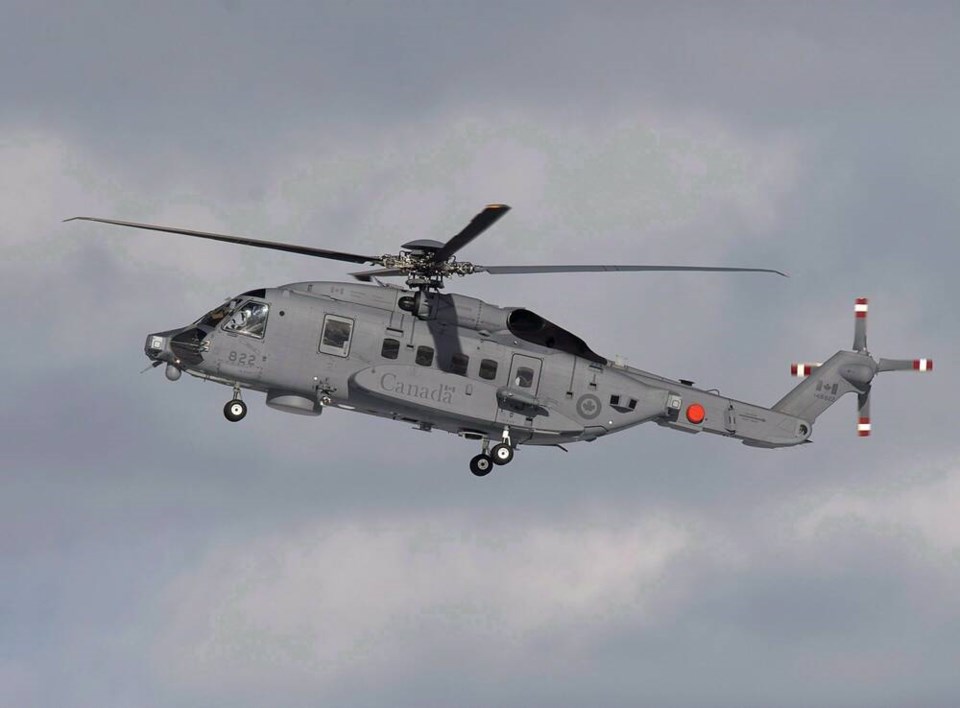The discovery of cracks in the tail of a military helicopter based at Patricia Bay has led to similar faults being found in 19 of Canada’s 23 Cyclone aircraft.
The Royal Canadian Air Force says the Sikorsky-made aircraft have not been grounded or placed on an operational pause. Engineering experts from the military are working with the company to repair the aircraft, the military said.
“Sikorsky has a plan to address the cracking, with each aircraft requiring a unique approach to repair the affected components,” a spokesperson said in an email. “The Royal Canadian Air Force expects that the first few aircraft affected by this issue will be repaired within the next few days.”
Tail cracks were first detected in one of the CH-148 Cyclones during a routine inspection on Nov. 26 at 443 Maritime Helicopter Squadron at Pat Bay. Six of the helicopters are based there. They are typically deployed to frigates at CFB Esquimalt and used for search and rescue, surveillance and anti-submarine duties.
On Monday, an aviation expert said the cracks detected in the Cyclones could be linked to the aircraft’s folding tail mechanism. Larry McWha, former commander of a CH-124 Sea King helicopter squadron in Nova Scotia, said he developed that hypothesis after noting the Cyclone’s manufacturer, Sikorsky Aircraft, had not issued any related directives about the civilian version of the helicopter, known as the S-92.
Unlike the CH-148 Cyclone, the S-92 does not have a folding tail boom, a feature that allows the Cyclone to fit inside the small hangars aboard Canada’s fleet of Halifax-class frigates.
The Department of National Defence said the military is still investigating the cause of the cracks and how to fix them.
The “maintenance issue” has had an impact on Operation LENTUS, the military’s effort to help those affected by the widespread flooding in B.C.
The military, however, has deployed other aircraft — including helicopters from Alberta, Quebec and Ontario, two Twin Otters from Yellowknife, and a Hercules transport plane — to the effort. On Nov. 15, Cormorant helicopters from CFB Comox evacuated 300 people, 26 dogs and a cat from the mainland’s Highway 7 when they were trapped by mudslides.
Canada placed an order for 28 Cyclones in 2004, but the helicopters did not start flying missions until 2018.
On April 29, 2020, a Cyclone carrying six military members crashed off the coast of Greece, killing all aboard. The crash marked the largest single-day loss of life for Canada’s military since it took part in the war in Afghanistan. The crash also cast a spotlight on the Cyclone’s long and problem-plagued development.
Defence procurement documents released this year show the $3.1-billion project is “facing financial challenges, increased procurement costs and some financial adjustments,” and that officials plan to ask the government for more money to finish it.
Canada’s top military procurement official warned at the time there would be no “quick fix” to the software issue identified as the primary cause of the crash last year. Troy Crosby, assistant deputy minister of materiel at the Department of National Defence, said officials were talking to Sikorsky to find ways to deal with the issue.
Two separate internal reviews by the Canadian Armed Forces found the autopilot on the helicopter — code-named Stalker 22 — took control of the aircraft as the pilot was turning to land on HMCS Fredericton.
A flight-safety review appeared to absolve Sikorsky of any responsibility, saying the type of manoeuvre that Stalker 22’s pilot was attempting to perform was not spelled out in the military’s documentation.
The commander of the Royal Canadian Air Force, Lt.-Gen. Al Meinzinger, has expressed confidence in the helicopter.



